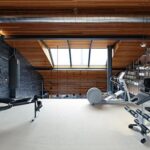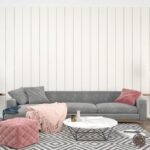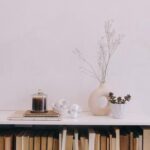Are you looking to create a cozy and inviting space in your home to unwind and immerse yourself in the world of literature? Learning how to decorate an at-home library is the perfect way to achieve just that.
A home library not only adds aesthetic value to your living space but also provides numerous benefits, including a quiet retreat for reading, studying, and relaxation. In this article, we will explore the essential elements of creating a home library that reflects your style, personality, and love for books.
The significance of having a home library extends beyond just a designated space for books. It serves as a sanctuary for those who appreciate the written word, offering a peaceful environment to escape the hustle and bustle of everyday life.
Furthermore, a well-designed at-home library can inspire creativity, foster intellectual curiosity, and encourage a love for lifelong learning. Whether you are an avid reader or simply enjoy collecting books as decorative pieces, having a dedicated space for your literary treasures creates a comfortable haven within your home.
Creating an at-home library allows you to curate an environment that is uniquely tailored to your preferences. From selecting the perfect location within your home to choosing the right bookshelves and organizing your collection, every aspect contributes to the overall ambiance of the space. This article will guide you through each step of the process, offering practical tips on how to bring together functional elements with personal touches to transform any room into an inviting and inspiring home library.
Choosing the Right Location
When creating an at-home library, the location is key to ensure that it serves as a functional and inviting space. Here are some tips for selecting the perfect spot for your private library:
- Consider lighting: Look for a space with ample natural light during the day to make reading easier on the eyes. If natural light is limited, consider adding adjustable lighting options such as floor lamps or wall sconces to create a cozy ambiance.
- Minimize noise: Select a location that is away from high traffic areas or noisy appliances to create a peaceful reading environment. Soundproofing materials can also be added to walls or doors if noise is a concern.
- Accessibility: Choose a location that is easily accessible and convenient to reach. This will ensure that you are more likely to utilize the space regularly without feeling inconvenienced.
By carefully considering these factors, you can create an at-home library in a location that best suits your needs and enhances your reading experience.
Selecting the Perfect Bookshelves
When it comes to creating the perfect at-home library, selecting the right bookshelves is a crucial element in achieving both functionality and aesthetics. There are various options to consider when choosing bookshelves, each with its own unique benefits and design considerations. Whether you opt for built-in shelving units, floating shelves, or traditional freestanding bookcases, careful consideration of your space and personal style will ensure that your home library meets your needs.
Built-in Bookshelves
Built-in bookshelves are a popular choice for those looking to maximize their storage space while creating a seamless and custom look. These shelves can be integrated directly into the walls of the room, providing a clean and cohesive appearance. Additionally, built-in bookshelves can be designed to fit any space, whether it’s a small corner or an entire wall. Customizing the size and configuration of these shelves allows for optimal storage and display of books and decorative items.
Floating Shelves
For a more modern and minimalist aesthetic, floating shelves offer a sleek and unobtrusive option for displaying your literary collection. These shelves are mounted directly onto the wall without visible brackets, creating the illusion of books floating on the wall. Floating shelves are ideal for small spaces or for adding a touch of contemporary flair to your home library. They also provide versatility in terms of arranging books and decor, as they can be easily adjusted to accommodate different heights.
Traditional Freestanding Bookcases
If you prefer a more classic look for your at-home library, traditional freestanding bookcases offer timeless charm and ample storage space. Available in various sizes, styles, and finishes, freestanding bookcases can complement any decor scheme.
They also provide flexibility in terms of placement within the room, allowing you to rearrange your space as needed without being tied to permanent fixtures. When selecting freestanding bookcases, consider factors such as height, depth, and material to ensure that they suit your specific storage needs while aligning with the overall design vision for your home library.
Organizing and Categorizing Books
When it comes to creating the perfect at-home library, organizing and categorizing your books is essential for both visual appeal and practicality. Whether you prefer to arrange your collection by genre, author, or even color, there are several strategies you can use to create a visually appealing and efficient system for finding your favorite reads.
By Genre
Arranging your books by genre is a classic method that allows for easy navigation of your collection. It also creates a cohesive look on your bookshelves. Consider grouping together categories such as fiction, non-fiction, mystery, science fiction, romance, and more. Within each genre, further organize books alphabetically by author or title for added convenience.
By Author
For avid readers who have a large collection of books by their favorite authors, organizing books alphabetically by author name can be a practical solution. This method makes it easy to find specific titles when you are in the mood for a particular writer’s style.
By Color
For those who prioritize aesthetics and want to create a visually striking display, arranging books by color can make for an eye-catching arrangement on your shelves. This approach adds a pop of color to your space and can serve as a unique design element in your home library.
Ultimately, the way you organize and categorize your books should be tailored to fit your personal preferences and lifestyle. Experiment with different methods to find what works best for you while also enhancing the overall look of your at-home library.
Creating a Cozy Reading Nook
When designing an at-home library, creating a cozy reading nook is essential for encouraging relaxation and the enjoyment of your space. Here are some ideas to help you create the perfect reading oasis:
- Comfortable Seating: Choose a comfortable armchair or chaise lounge where you can relax and get lost in a good book. Consider adding some soft throw blankets and fluffy pillows to make your reading nook extra cozy and inviting.
- Adequate Lighting: Good lighting is crucial for a reading nook. Consider adding a floor lamp or table lamp to ensure that the space is well-lit for reading, while also creating a warm and inviting ambiance.
- Personal Touches: Incorporate personal touches such as family photos, artwork, or sentimental items that reflect your unique style and personality. Adding these personal elements will make the space feel more intimate and enjoyable.
- Quiet Atmosphere: When creating your cozy reading nook, consider the location within your home to ensure it’s a quiet area where you can escape from distractions and fully immerse yourself in the joy of reading.
By incorporating these elements into your at-home library, you can create a cozy reading nook that invites relaxation and makes spending time with your favorite books even more enjoyable.
Adding Personal Touches
Once you have chosen the perfect location for your at-home library, and organized your bookshelves, it’s time to add some personal touches to make the space truly your own. One way to do this is by incorporating personal mementos such as family photos, travel souvenirs, or heirlooms that hold sentimental value. These items not only add character to your library but also make it a warm and inviting space for you and your guests.
In addition to personal mementos, consider adding artwork and decorations that reflect your unique style and interests. Whether you prefer classic paintings, contemporary sculptures, or vintage posters, the artwork in your home library can serve as a reflection of your personality and passions. By carefully selecting pieces that resonate with you, you can create a visually stimulating environment that inspires creativity and intellectual curiosity.
Another way to personalize your at-home library is by incorporating thematic decorations that align with your favorite literary genres or topics of interest. For example, if you are an avid fan of mystery novels, consider adding detective memorabilia or vintage typewriters as decorative elements.
If science fiction is more your style, futuristic art pieces or collectible figurines can add a playful touch to the space. Ultimately, the key is to curate a collection of items that bring joy and meaning to the room while celebrating your individuality.
| Personal Touches | Benefits |
|---|---|
| Incorporating personal mementos and artwork | Adds character and warmth to the space |
| Thematic decorations | Celebrates individuality and passions |
Lighting and Ambiance
It is essential to pay attention to lighting when creating a home library. The right lighting can contribute greatly to the ambiance of the space, making it cozy and inviting for reading and relaxation. Natural light is ideal for a home library, so choosing a location with ample windows is preferable. However, for evening or cloudy days, it’s crucial to have artificial lighting that complements the space.
While selecting lighting fixtures for your home library, consider options that provide a warm and soft glow. Avoid harsh overhead lights that can cause glare on book pages and strain your eyes. Instead, opt for floor lamps, table lamps, or wall-mounted sconces that direct light toward the seating and reading areas. Additionally, dimmer switches can be useful since they allow you to adjust the brightness according to your needs and mood.
When it comes to ambiance in a home library, adding some personal touches can enhance the overall atmosphere of the space. Consider incorporating elements like scented candles or essential oil diffusers to create a relaxing aroma. Soft music playing in the background can also elevate the ambiance and make the space more enjoyable for extended periods of reading time.
| Lighting Options | Ambiance Enhancements |
|---|---|
| Natural light from windows | Scented candles or essential oil diffusers |
| Floor lamps or table lamps | Soft music playing in the background |
Incorporating Functional Elements
A reading desk is a valuable addition to any home library, providing a designated space for studying, writing, or working on creative projects. When choosing a desk, consider factors such as size, comfort, and storage options to maximize its functionality.
Additionally, incorporating charging stations for electronic devices can help keep your gadgets organized and ready for use while spending time in your library. By strategically placing these stations near seating areas or workstations, you can ensure easy access to power sources without compromising the aesthetic appeal of the space.
Ergonomic furniture is another important consideration when designing your home library. Comfortable seating options such as chairs and sofas with proper back support can enhance the overall reading experience and encourage prolonged periods of relaxation.
Additionally, incorporating adjustable lighting fixtures and comfortable work surfaces can contribute to a healthy and productive environment within your home library. By carefully integrating these functional elements into your at-home library, you can create a space that not only reflects your personal style but also enhances your everyday living experience through its practicality and efficiency.
Frequently Asked Questions
How Can I Make My Library Attractive?
Making your library attractive can involve several key elements. First, consider the layout and organization of the space, making sure it’s conducive to browsing and reading. Incorporating comfortable seating and good lighting is also important to create a welcoming environment.
Adding decorative elements like artwork, plants, or cozy rugs can enhance the ambiance. And don’t forget about the selection of books – a diverse and engaging collection will make your library more appealing to visitors.
How Do I Set Up a Small Library at Home?
Setting up a small library at home can be a rewarding project. Begin by selecting a dedicated space for your library, whether it’s a spare room, an alcove, or even just a corner of a larger room. Invest in bookshelves or storage units to keep your books organized and easily accessible.
Consider incorporating comfortable seating like chairs or sofas, along with good lighting for reading. Don’t forget to personalize the space with decorative touches that reflect your personal style and interests.
What Colors Are Good for Home Library?
When choosing colors for your home library, consider creating a cozy and inviting atmosphere by opting for warm, rich tones like deep reds, dark greens, or golden yellows. These colors can create a sense of warmth and comfort that is ideal for reading and relaxation.
Additionally, incorporating wood tones through furniture or shelving can complement these color choices and add to the overall aesthetic of the space. Ultimately, select colors that reflect your personal preferences while also creating an environment conducive to reading and leisurely enjoyment.

I’m thrilled to be your companion on this exciting journey through the world of home decor and design. With a passion for turning houses into homes and a keen eye for the finer details, I’m here to help you transform your living spaces into beautiful, functional, and meaningful havens.





